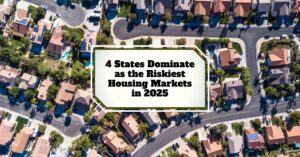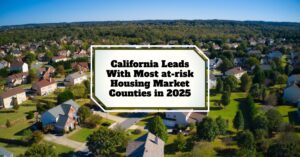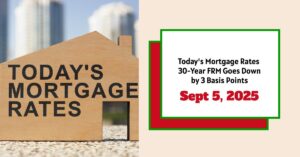As we navigate the housing market in 2025, a clear picture is emerging: California, Florida, Louisiana, and New Jersey are showing the highest levels of risk, according to ATTOM's latest data. Homeownership, a dream for many, is becoming a significant financial tightrope walk in these areas, driven by a challenging mix of high living costs, precarious job markets, and housing values that are starting to feel the strain.
It's easy to get caught up in the headlines about soaring home prices, and believe me, those numbers can be staggering. But as someone who's been tracking real estate trends for a while, I know that price tags are only a piece of a much bigger puzzle. What really matters is whether people can actually afford to keep those homes, month after month, year after year. And in several states, that ability is seriously being tested.
When we talk about a “risky” housing market, we're not just saying property values might drop a little. We're looking at a combination of factors that create a genuine threat of financial instability for homeowners. This includes how much of their income people need to fork over for mortgage payments, property taxes, and insurance. It also looks at whether people owe more on their mortgage than their home is worth (that's being “underwater”), how many people are actually falling behind on their payments or facing foreclosure, and the general health of the local job market.
My take on this? The data from ATTOM paints a concerning, but not entirely surprising, picture. We've seen periods of rapid price growth in many of these states, and while that might seem like good news on the surface, it can also mask underlying weaknesses. When wages and job security don't keep pace with those soaring home costs, you create a situation where a significant portion of the population is living on the edge.
Let's dive deeper into what's making these four states stand out as particularly vulnerable in 2025.
4 States Dominate as the Riskiest Housing Markets in 2025
The Key Ingredients of Housing Market Risk
Before we point fingers at specific states, it's important to understand the recipe ATTOM uses to determine housing market risk. Think of it like a diagnostic test for your local housing economy. They're looking at four main ingredients:
- Home Affordability: This is a big one. How much of a typical person's income is chewed up by mortgage payments, property taxes, and insurance? If it's taking more than a third of your paycheck, that's a red flag. In some of the counties they looked at, this number was well over half your income, and in a few extreme cases, it was more than your entire year's pay just for the basics of owning a home!
- Seriously Underwater Mortgages: This means homeowners owe at least 25% more on their mortgage than their home is actually worth. Imagine trying to sell your house in this situation – you'd actually lose money. About 39% of the counties studied had a higher percentage of these underwater mortgages, and the problem is particularly bad in Louisiana.
- Foreclosure Rates: This is a direct indicator of financial distress. When people can't make their payments, foreclosures happen. ATTOM found that about 1 in every 1,413 homes nationwide were facing foreclosure in the second quarter of 2025. However, in some counties, this rate was much higher, like one in every 355 homes in Dorchester County, South Carolina.
- Unemployment Rates: A healthy job market is the bedrock of a stable housing market. When people are out of work, they can't pay their mortgages. ATTOM found that around 35% of counties had unemployment rates higher than the national average. California showed some of the highest joblessness figures, with Imperial County hitting a staggering 19% unemployment.
When a county or state shows high numbers across all of these categories, that’s when you know you've got a serious risk on your hands.
California: The Golden State's Gilded Cage
California is unique. It has it all: stunning coastlines, innovation hubs, and a booming economy. But as we move through 2025, it's also home to the most counties facing significant housing risk, with 14 counties making ATTOM's list of the 50 highest-risk markets.
California's issues often stem from its incredibly high cost of living and, specifically, its astronomical housing prices. We saw areas where housing expenses devoured more than double a typical resident's annual wages. Think about that: you're working your tail off all year, and just to cover your house payment, taxes, and insurance, you'd need to earn more than you actually did. That's not sustainable.
Furthermore, California has experienced its share of economic bumps. While tech remains strong in some areas, other parts of the state are dealing with slower job growth, and the lingering effects of wildfires haven't helped property values in a lot of communities. Unemployment rates in counties like Imperial County (19%) and Tulare County (10.8%) are far above the national average, creating a double whammy of high housing costs and fewer job prospects. The situation in areas like Humboldt, Shasta, and Butte Counties, which have been hit hard by recent wildfires, is particularly gut-wrenching, as they now face rebuilding their economies on top of dealing with market instability.
Florida: The Sunshine State's Storm Clouds
Florida has long been a magnet for new residents, drawn by its warm weather and attractive lifestyle. However, in 2025, it's also landing a significant number of counties on the riskiest housing market list, with seven counties identified among the top 50.
The Sunshine State's challenges are often tied to its rapid growth and how that impacts affordability. While home prices have been high, wage growth hasn't always kept pace. This means that for many Floridians, the dream of homeownership is becoming increasingly out of reach, forcing them to allocate a larger portion of their income to housing.
ATTOM data points to Charlotte County, Florida, as a specific area to watch. It's not only among the riskiest counties overall but also shows a worrying foreclosure rate, with one in every 372 homes facing foreclosure. This indicates that a segment of homeowners are struggling to keep up with their mortgage payments, perhaps after buying when prices were lower or taking on loans that are now too burdensome. The state's general high cost of living, combined with the potential for natural disasters that can impact insurance costs and property values, adds another layer of vulnerability.
Louisiana: The Bayou State's Deepwater Woes
Louisiana's housing market presents a uniquely challenging picture, with four counties making their way onto the list of the 50 riskiest. What makes Louisiana stand out in this analysis is the alarming rate of homeowners who are seriously underwater on their mortgages.
Seven of the top ten counties nationally with the highest underwater mortgage rates are in Louisiana. We're talking about places like Rapides Parish (17.3% of homes underwater), Calcasieu Parish (16.9%), and Caddo Parish (14.3%). This means that a substantial number of homeowners in these areas owe far more on their homes than they are worth. If they needed to sell, they would lose a significant chunk of money. This lack of equity makes it incredibly difficult for people to sell their homes and move on, trapping them in potentially unmanageable financial situations.
Beyond the underwater mortgages, Louisiana also faces challenges with unemployment and affordability in certain regions. The combination of these factors paints a concerning picture for many Louisiana homeowners.
New Jersey: The Garden State's Growing Pains
New Jersey, often seen as a commuter state for New York and Philadelphia, is also grappling with housing market risks, with five counties appearing on ATTOM's list of the 50 highest-risk markets.
The Garden State's housing market is significantly impacted by its high property taxes and the general cost of living. This can make affordability a major concern, even for those with relatively good incomes. When you add in the potential for economic slowdowns in surrounding major metropolitan areas or shifts in employment trends, the pressure on New Jersey homeowners can intensify.
While specific foreclosure and unemployment data for individual counties within New Jersey might vary, the presence of several counties on the broader “riskiest” list suggests a widespread pattern of financial strain. We see counties like Cumberland County, NJ, flagged as one of the riskiest due to a combination of factors. This might include a less robust job market compared to neighboring states or areas where housing prices, while not as extreme as California, still represent a significant burden on household budgets.
What Does This Mean for Homeowners and Buyers?
The reality of these “risky” markets isn't just about statistics; it's about people's lives and financial futures.
-
For Current Homeowners: If you live in one of these states, it's crucial to have a clear understanding of your financial situation.
- Assess your equity: How much are you actually “up” on your home? If you're close to being underwater, consider whether you have the ability to build more equity through extra payments or home improvements.
- Review your budget: Can you comfortably afford your mortgage, taxes, and insurance, even if interest rates fluctuate or you face unexpected expenses?
- Stay informed: Keep an eye on local job market trends and economic news in your area.
-
For Prospective Buyers: These markets require extra diligence.
- Don't stretch your budget: Be realistic about what you can afford. A slightly smaller but more affordable home in a stable market might be a wiser long-term investment than a dream home in a high-risk area.
- Explore different neighborhoods: Sometimes, just a few miles away can make a significant difference in affordability and risk.
- Understand the local economy: What are the main industries? Is the job market growing or shrinking? This insight is invaluable.
- Consult with professionals: A good mortgage lender and a knowledgeable real estate agent can provide essential guidance tailored to your specific situation and the local market.
My Takeaway: Prudence is Key
Looking at this data, my primary feeling is one of caution. While real estate has historically been a solid investment, the current economic climate—marked by sticky inflation, fluctuating interest rates, and job market uncertainties—means we can't afford to be complacent. The “boom” years of low interest rates and rapidly appreciating values might be more distant than we think.
The fact that southern states, in particular, are showing up at both the riskiest and least risky ends of the spectrum highlights immense regional variation. This isn't a one-size-fits-all scenario. However, the heavy presence of California, Florida, Louisiana, and New Jersey on the “risky” side is a strong signal. It tells us that the fundamental principles of homeownership—affordability, job security, and responsible borrowing—remain the most critical factors for long-term financial health.
For anyone thinking about buying or selling, or even just holding onto their property, understanding these risk factors is paramount. It’s about making informed decisions, not just emotional ones. The housing market is a powerful engine, but it requires careful navigation, especially in 2025.
Invest in Real Estate in the Top U.S. Markets
Discover high-quality, ready-to-rent properties designed to deliver consistent returns.
Contact Norada today to expand your real estate portfolio with confidence.
Contact our investment counselors (No Obligation):
(800) 611-3060
Also Read:
- Housing Market Predictions: Home Prices to Drop by 0.9% in 2025
- Housing Market Predictions 2025 by Norada Real Estate
- Housing Market Predictions 2025 by Warren Buffett's Berkshire Hathaway
- Will the Housing Market Crash in 2025: What Experts Predict?
- Housing Market Predictions 2026: Will it Crash or Boom?
- Housing Market Predictions for the Next 4 Years: 2025 to 2029
- Real Estate Forecast: Will Home Prices Bottom Out in 2025?
- Real Estate Forecast Next 5 Years: Top 5 Predictions for Future
- Will Real Estate Rebound in 2025: Top Predictions by Experts
- Real Estate Forecast Next 10 Years: Will Prices Skyrocket?











